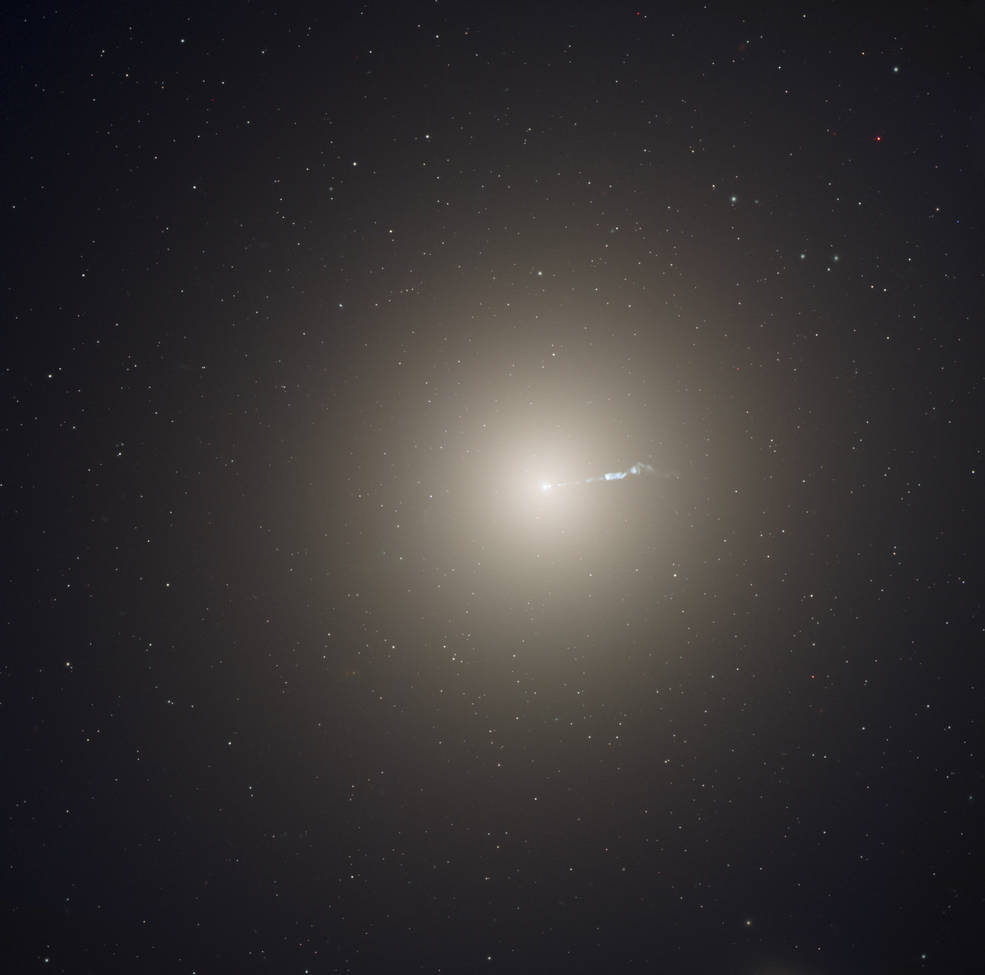Maunakea, Hawaiʻi – A UC Berkeley-led team of astronomers has for the first time measured the three-dimensional shape of Messier 87 (M87), one of the biggest and closest elliptical galaxies to us. New data from W. M. Keck Observatory on Maunakea in Hawaiʻi show M87 isn’t perfectly symmetrical after all, but rather triaxial – similar to the uneven shape of a potato.
The study is published in The Astrophysical Journal Letters.
Located about 55 million light-years away from Earth in the constellation Virgo, M87 is close enough to see using binoculars or a small telescope. As with most celestial objects viewed from our vantage point, M87 appears flat.
The galaxy’s true form revealed itself through the lens of Keck Observatory’s cutting-edge instrument called the Keck Cosmic Web Imager (KCWI), which captures 3D data as opposed to the traditional 2D image or spectrum from conventional instruments.
The researchers used KCWI along with star brightness measurements of M87 from NASA’s Hubble Space Telescope to assemble a 3D view of the motion of stars orbiting M87’s supermassive black hole, named Pōwehi by Larry Kimura, a Hawaiian language professor at the University of Hawaiʻi at Hilo. This provided fresh insight into the galaxy’s shape and allowed the team to calculate with higher precision Pōwehi’s mass, which came out to about 5.4 billion times the mass of the Sun. Previous measurements taken in 2017 when the Event Horizon Telescope (EHT) snapped a direct image of Pōwehi found its mass to be about 6.5 billion solar masses.
Pōwehi means ‘embellished dark source of unending creation’ in Hawaiian and is the world’s first black hole to have its picture taken using EHT’s network of telescopes around the planet, including two Maunakea Observatories – the James Clerk Maxwell Telescope and the Submillimeter Array.

While KCWI was unable to resolve the individual stars due to M87’s great distance from Earth, it was able to obtain spectra that revealed the range of the stars’ velocities as they whizzed around Pōwehi.
“It’s sort of like looking at a swarm of 100 billion bees that are going around in their own happy orbits,” said Chung-Pei Ma, a UC Berkeley professor of astronomy and of physics who led the research team. “Though we are looking at them from a distance and can’t discern individual bees, we are getting very detailed information about their collective velocities. It’s really the superb sensitivity of this spectrograph that allowed us to map out M87 so comprehensively.”
Ma, UC Berkeley graduate student and lead author of the study Emily Liepold, and Jonelle Walsh at Texas A&M University pointed the Keck II telescope at 62 locations across the galaxy and captured KCWI spectra of stars covering a region spanning 70,000 light years across. Gravity in the central 3,000 light-years of this region is largely dominated by Pōwehi. This marked the first time KCWI has been used to reconstruct the geometry of a distant galaxy.
“The Keck data are so good that we can measure the intrinsic shape of M87 along with the black hole at the same time,” said Ma. “We made the first measurement of the actual 3D shape of the galaxy. And since we allowed the swarm of bees to have a more general shape than just a sphere or disk, we have a more robust dynamical measurement of the mass of the central black hole that is governing the bees’ orbiting velocities.”
Ma’s team was also able to measure M87’s rotation, which clocks in at a relatively sedate 25 kilometers per second.
The new findings pave the way for an exciting investigation into M87 that wasn’t possible before – determining Pōwehi’s spin.
“Now that we know the direction of the net rotation of stars in M87 and have an updated mass of the black hole, we can combine this information with the amazing data from the EHT team to constrain the spin,” said Ma. “This may point toward a certain direction and range of spin for the black hole, which would be remarkable.”
Learn more:
- “3D Picture of Galaxy M87 Helps Pin Down Mass of the Black Hole at its Core” – UC Berkeley Press Release April 13, 2023
- “Giant Galaxy Seen in 3D by NASA’s Hubble Space Telescope and Keck Observatory” – STScI Press Release, April 13, 2023
ABOUT KCWI
The Keck Cosmic Web Imager (KCWI) is designed to provide visible band, integral field spectroscopy with moderate to high spectral resolution formats and excellent sky-subtraction. The astronomical seeing and large aperture of the telescope enables studies of the connection between galaxies and the gas in their dark matter halos, stellar relics, star clusters, and lensed galaxies. Support for this project was provided by the National Science Foundation, Heising-Simons Foundation, and Mt. Cuba Astronomical Foundation.
ABOUT W. M. KECK OBSERVATORY
The W. M. Keck Observatory telescopes are among the most scientifically productive on Earth. The two 10-meter optical/infrared telescopes atop Maunakea on the Island of Hawaii feature a suite of advanced instruments including imagers, multi-object spectrographs, high-resolution spectrographs, integral-field spectrometers, and world-leading laser guide star adaptive optics systems. Some of the data presented herein were obtained at Keck Observatory, which is a private 501(c) 3 non-profit organization operated as a scientific partnership among the California Institute of Technology, the University of California, and the National Aeronautics and Space Administration. The Observatory was made possible by the generous financial support of the W. M. Keck Foundation. The authors wish to recognize and acknowledge the very significant cultural role and reverence that the summit of Maunakea has always had within the Native Hawaiian community. We are most fortunate to have the opportunity to conduct observations from this mountain.


